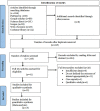Towards universal health coverage: The level and determinants of enrollment in the Community-Based Health Insurance (CBHI) scheme in Ethiopia: A systematic review and meta-analysis
- PMID: 35980888
- PMCID: PMC9387799
- DOI: 10.1371/journal.pone.0272959
Towards universal health coverage: The level and determinants of enrollment in the Community-Based Health Insurance (CBHI) scheme in Ethiopia: A systematic review and meta-analysis
Abstract
Background: Community-based health insurance (CBHI) is a risk-pooling approach that tries to disperse health expenditures across families with varying health profiles to provide greater access to healthcare services by allowing cross-subsidies from wealthy to poor populations. It is crucial to assess the level of CBHI enrolment and its determinants in Ethiopia, where government health spending is limited to less than 5% of GDP, far below the Alma Ata Declaration's benchmark of 15%. Although various epidemiological studies on CBHI enrolment status and its determinants have been undertaken in Ethiopia, the results have been inconsistent, with significant variability. However, no nationwide study assessing the pooled estimates exists today. Furthermore, the estimated strength of association at the country level varied and was inconsistent across studies. Hence, this systematic review and meta-analysis aimed at estimating the pooled prevalence of CBHI enrolment and its determinants in Ethiopia.
Methods: A comprehensive search of studies was done by using PubMed, EMBASE, Science Direct, HINARI, Scopus, Web of Science, and the Cochrane Library. The database search was complemented by google scholar and some repositories for grey literature. The search was carried out from February 11 to March 12, 2022. The relevant data were extracted using a Microsoft Excel 2013 spreadsheet and analyzed using STATATM Version 16. Studies reporting the level and determinants of CBHI enrolment in Ethiopia were considered. A weighted DerSimonian Laired random effect model was applied to estimate the pooled national prevalence of CBHI enrolment. The Cochrane Q test statistics and I2 tests were used to assess the heterogeneity of the included studies. A funnel plot, Begg's and Egger's tests, were used to check for the presence of publication bias.
Results: Fifteen studies were eligible for this systematic review and meta-analysis with a total of 8418 study participants. The overall pooled prevalence of CBHI enrolment in Ethiopia was 45.5% (95% CI: 32.19, 58.50). Affordability of premium for the scheme[OR = 2.58, 95% CI 1.68, 3.47], knowledge of respondents on the CBHI scheme[OR = 4.35, 95% CI 2.69, 6.01], perceived quality of service[OR = 3.21, 95% CI 2.04, 4.38], trust in the scheme[OR = 2.32, 95% CI 1.57, 3.07], and the presence of a person with a chronic disease in the household [OR = 3.58, 95% CI 2.37, 4.78] were all found to influence CBHI enrolment.
Conclusion: Community health workers (CHWs) need to make a high effort to improve knowledge of CBHI in rural communities by providing health education. To deal with the issue of affordability, due emphasis should be placed on building local solidarity groups and strengthening local initiatives to aid poor members. Stakeholders in the health service delivery points need to focus on the dimensions of high service quality. The financial gap created by the adverse selection of households with chronically ill members should be rectified by implementing targeted subsidies with robust plans.
Conflict of interest statement
The authors have declared that no competing interests exist.
Figures











Similar articles
-
Household satisfaction and associated factors with community-based health insurance scheme in Ethiopia: systematic review and meta-analysis.Glob Health Res Policy. 2023 Sep 15;8(1):41. doi: 10.1186/s41256-023-00325-y. Glob Health Res Policy. 2023. PMID: 37710337 Free PMC article.
-
Willingness to join community-based health insurance and associated factors among households in Ethiopian: a systematic review and meta-analysis.Cost Eff Resour Alloc. 2025 Apr 10;23(1):12. doi: 10.1186/s12962-025-00620-0. Cost Eff Resour Alloc. 2025. PMID: 40211299 Free PMC article. Review.
-
Pooled coverage of community based health insurance scheme enrolment in Ethiopia, systematic review and meta-analysis, 2016-2020.Health Econ Rev. 2022 Jul 12;12(1):38. doi: 10.1186/s13561-022-00386-8. Health Econ Rev. 2022. PMID: 35819505 Free PMC article. Review.
-
Determinants of community-based health insurance membership renewal decision among rural households in Kellem Wollega zone, Oromia regional state, Ethiopia: a community-based cross-sectional study.Front Public Health. 2024 Jan 4;11:1192991. doi: 10.3389/fpubh.2023.1192991. eCollection 2023. Front Public Health. 2024. PMID: 38239796 Free PMC article.
-
The prevalence of respectful maternity care during childbirth and its determinants in Ethiopia: A systematic review and meta-analysis.PLoS One. 2022 Nov 23;17(11):e0277889. doi: 10.1371/journal.pone.0277889. eCollection 2022. PLoS One. 2022. PMID: 36417397 Free PMC article.
Cited by
-
Household satisfaction and associated factors with community-based health insurance scheme in Ethiopia: systematic review and meta-analysis.Glob Health Res Policy. 2023 Sep 15;8(1):41. doi: 10.1186/s41256-023-00325-y. Glob Health Res Policy. 2023. PMID: 37710337 Free PMC article.
-
Rural-urban disparity in community-based health insurance enrollment in Ethiopia: a multivariate decomposition analysis using Ethiopian Mini Demographic Health Survey 2019.Front Public Health. 2024 Jul 29;12:1361793. doi: 10.3389/fpubh.2024.1361793. eCollection 2024. Front Public Health. 2024. PMID: 39145179 Free PMC article.
-
Inappropriate antibiotic access practices at the community level in Eastern Ethiopia.Sci Rep. 2024 Aug 1;14(1):17751. doi: 10.1038/s41598-024-67688-1. Sci Rep. 2024. PMID: 39085272 Free PMC article.
-
Making health insurance responsive to citizens: the management of members' complaints by mutual health organisations in Kinshasa, Democratic Republic of Congo.BMJ Glob Health. 2023 Sep;7(Suppl 6):e011438. doi: 10.1136/bmjgh-2022-011438. BMJ Glob Health. 2023. PMID: 37666577 Free PMC article.
-
Spatial variation and predictors of missing birth preparedness and complication readiness (BPCR) messages in Ethiopia.PLoS One. 2023 Dec 8;18(12):e0295744. doi: 10.1371/journal.pone.0295744. eCollection 2023. PLoS One. 2023. PMID: 38064521 Free PMC article.
References
-
- World Health Organization, World Bank,Tracking universal health coverage: 2017 global monitoring report. Switzerland; 13 dec 2017. 122029-WP-REVISED-PUBLIC.pdf [Internet]. [cited 2022 Jan 25]. Available from: https://apps.who.int/iris/bitstream/handle/10665/259817/9789241513555-en...
-
- Desa U., Transforming our world: The 2030 agenda for sustainable development. 2016.
Publication types
MeSH terms
LinkOut - more resources
Full Text Sources
Research Materials
Miscellaneous

